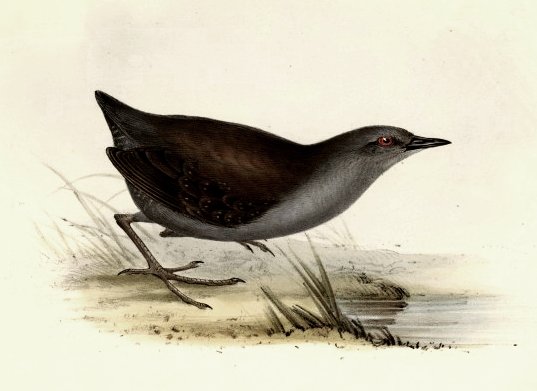- Galapagos Rail
status = VU | status_system = IUCN3.1
trend = down
regnum =Animal ia
phylum = Chordata
classis = Aves
ordo =Gruiformes
familia =Rallidae
genus = "Laterallus "
species = "L. spilonotus"
binomial = "Laterallus spilonotus"
binomial_authority = (Gould,1841 )The Galapagos Rail, "Laterallus spilonotus", is a small rail endemic to the
Galapagos Islands . It resembles the closely relatedBlack Rail ofThe Americas . It is threatened byintroduced species , such as goats and cats, and is considered vulnerable.Description
The Galapagos Rail is a small (15 cm) nearly flightless ground living
bird . It has darkplumage , black overall with a greyer head and breast, and white spots on the back. It has a scarlet eye, a black bill, and short, nearly uselesswing s. They are very vocal with a wide range of calls.Habits
The Galapagos Rail lives in moist
grassland s andforest ,skulking in deep cover. In the Galapagos these habitats are generally found on islands with higher elevations (particularly on the islands of Santiago, Santa Cruz and Sierra Negra), and the rails are commonest higher up. They feed ininvertebrate s, mostlysnail s,isopod s, dragonflies, bugs,ant s, also taking berries and some seeds. They feed during the day, moving along the ground tossing leaves and investigating the leaf litter.Galapagos Rails and humans
The Galapagos Rail, despite being a nearly flightless island living rail, has managed to survive the arrival of humans in the Galapagos. It is a confiding species that is curious of humans and will approach and investigate them, this naivety makes it vulnerable to
feral cat s,dog s andpig s. Introducedgoat s andcattle also cause habitat loss that causes a drop in their numbers. The removal of goats and cattle, and the resulting regeneration of trees, shrubs and grasses, leads quickly to a return of the rail. As most of the Galapagos Rail's habitat lies in anational park , and efforts are underway to remove the introduced species doing the most harm, the future is looking better for these birds.References
* Database entry includes justification for why this species is vulnerable
* Taylor, B. (1998) "Rails, a Guide to the Rails, Crakes, Gallinules and Coots of the World", Yale University Press, ISBN 978-0300077582External links
* [http://www.birdspix.com/GALAPAGOS%20COLLECTION/Galapagos%20Rail%20page.html Galápagos Rail Photographs] - John S. Schwarz Bird Photography
* [http://www.birdlife.org/datazone/search/species_search.html?action=SpcHTMDetails.asp&sid=2843&m=0 BirdLife International: Galapagos Rail]
Wikimedia Foundation. 2010.

